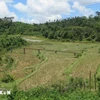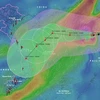Fifteen new caves and three new species have been discovered in the central province of Quang Binh by an expedition from the UK’s Cave Research Association.
The discoveries were made during the team’s return visit to Son Doong in March.
Explorer Howard Limbirt told the Lao Dong (Labour) newspaper that three caves, called Ken, Tu Lan and To Mo, were found in Minh Hoa district and have been added to the global list of GPS maps and the 12 others were discovered in the UNESCO-listed Phong Nha-Ke Bang National Park.
These are unexpected achievements for the professional circle, said an expedition spokesperson, adding that these caves are very important to geomorphology and the geology sector.
The expedition said that they also found a species of fish that swims against the waterfall’s currents in Tu Lan cave but they have not yet been able to identify it.
According to the expedition, Son Doong cave, which was first found and named by local explorer Ho Khanh and previously held the record as the biggest cave in the world, with a height of 150m and width of 200m, has now set new records.
The team found a new chamber in the cave which is the largest of its kind in the world with a height reaching 200m and up to 250m at some spots. A giant wall, which is more than 200m high, was also discovered and took the team more than two days to explore using ropes.
The wall in Son Doong cave can now be analysed by scientists to evaluate the age of the cave, said an expedition spokesperson.
Also at Son Doong cave, the scientists found two primitive forests, one at the cave’s mouth and the other at an opening further inside the cave. They also detected three new species in the forests including one fish, one spider and one myriapod.
They also came across the fossil of a carnivorous animal, a species of beautiful stone mushroom and numerous stone balls formed from pure limestone.
Explaining why Son Doong cave is the world’s biggest, Limbirt said that the cave lies in a giant limestone formation and was created over millions of years by erosion from floods. It took almost 12 months to measure, study and calculate the data to work out this simple explanation, said Limbirt./.
The discoveries were made during the team’s return visit to Son Doong in March.
Explorer Howard Limbirt told the Lao Dong (Labour) newspaper that three caves, called Ken, Tu Lan and To Mo, were found in Minh Hoa district and have been added to the global list of GPS maps and the 12 others were discovered in the UNESCO-listed Phong Nha-Ke Bang National Park.
These are unexpected achievements for the professional circle, said an expedition spokesperson, adding that these caves are very important to geomorphology and the geology sector.
The expedition said that they also found a species of fish that swims against the waterfall’s currents in Tu Lan cave but they have not yet been able to identify it.
According to the expedition, Son Doong cave, which was first found and named by local explorer Ho Khanh and previously held the record as the biggest cave in the world, with a height of 150m and width of 200m, has now set new records.
The team found a new chamber in the cave which is the largest of its kind in the world with a height reaching 200m and up to 250m at some spots. A giant wall, which is more than 200m high, was also discovered and took the team more than two days to explore using ropes.
The wall in Son Doong cave can now be analysed by scientists to evaluate the age of the cave, said an expedition spokesperson.
Also at Son Doong cave, the scientists found two primitive forests, one at the cave’s mouth and the other at an opening further inside the cave. They also detected three new species in the forests including one fish, one spider and one myriapod.
They also came across the fossil of a carnivorous animal, a species of beautiful stone mushroom and numerous stone balls formed from pure limestone.
Explaining why Son Doong cave is the world’s biggest, Limbirt said that the cave lies in a giant limestone formation and was created over millions of years by erosion from floods. It took almost 12 months to measure, study and calculate the data to work out this simple explanation, said Limbirt./.



















